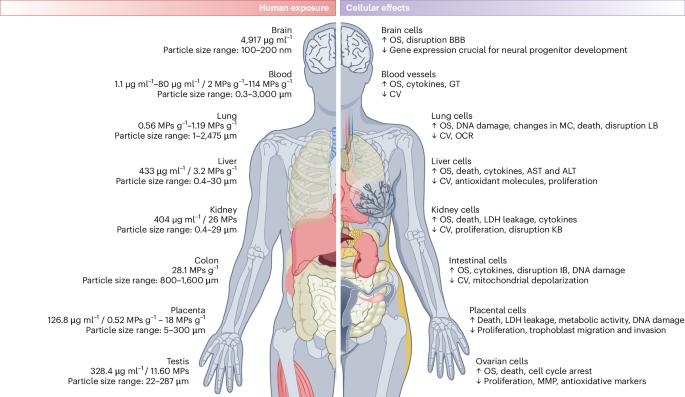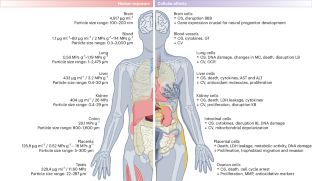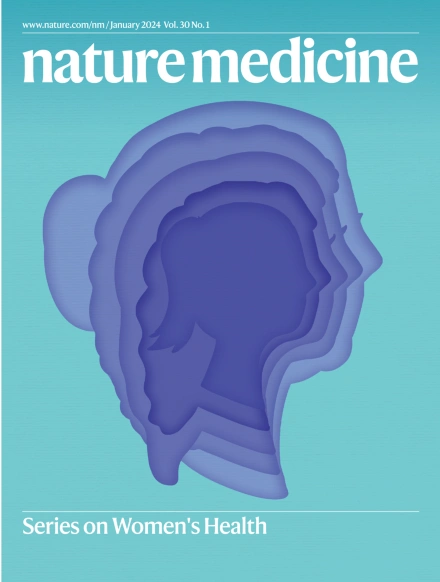接触微塑料和纳米塑料对健康的影响
IF 50
1区 医学
Q1 BIOCHEMISTRY & MOLECULAR BIOLOGY
引用次数: 0
摘要
随着证明人体中存在微塑料和纳米塑料(MNPs)的证据越来越多,对其潜在健康影响的担忧也越来越多。多种因素决定了mnps的性质和行为,包括聚合物类型、大小、形状和生物冕的存在等,这对评估潜在不利健康影响的分析方法和工具提出了很高的要求。实验模型表明,MNPs可以穿过人体肺部和肠道的细胞屏障,到达体循环,随后到达生殖器官、胎盘和大脑等组织。早期临床结果表明,MNPs可能与不良健康结果有关,包括免疫调节、生殖影响和心血管影响。然而,这些研究通常存在患者数量少和MNP暴露评估不充分的问题,因此无法进行充分的风险评估。尽管如此,基于动物和细胞的分析结果总体上支持初步的临床发现。为了进行更有力的人体研究,暴露和影响评估方法的成熟至关重要。解决这些挑战将改进对非移民国家健康影响的科学研究,这是迫切需要的。本文章由计算机程序翻译,如有差异,请以英文原文为准。


Health impacts of microplastic and nanoplastic exposure
As evidence demonstrating the presence of micro- and nanoplastics (MNPs) in the human body accumulates, so do concerns about their potential health impacts. Multiple factors determine the properties and behavior of MNPs—including polymer type, size, shape and the presence of a biocorona, among others—which place high demands on analytical methodology and tools for assessment of potential adverse health effects. Experimental models have shown that MNPs can cross cell barriers in the human lung and intestine and reach systemic circulation and subsequently tissues such as reproductive organs, placenta and brain. Early clinical findings indicate that MNPs may be associated with adverse health outcomes, including immune modulation, reproductive effects and cardiovascular effects. However, these studies typically suffer from low patient numbers and inadequate MNP exposure assessment, which precludes adequate risk assessment. Still, outcomes from animal and cell-based analyses generally support the preliminary clinical findings. To conduct more robust human studies, maturation of methods for exposure and effect assessment are crucial. Addressing these challenges will improve scientific research on the health impact of MNPs, which is urgently needed. There are strong indications that MNP exposure negatively impacts human health, but a robust evidence base is lacking. This Review focuses on the current state of the science, offering a critical review of the data, analytical challenges and research priorities.
求助全文
通过发布文献求助,成功后即可免费获取论文全文。
去求助
来源期刊

Nature Medicine
医学-生化与分子生物学
CiteScore
100.90
自引率
0.70%
发文量
525
审稿时长
1 months
期刊介绍:
Nature Medicine is a monthly journal publishing original peer-reviewed research in all areas of medicine. The publication focuses on originality, timeliness, interdisciplinary interest, and the impact on improving human health. In addition to research articles, Nature Medicine also publishes commissioned content such as News, Reviews, and Perspectives. This content aims to provide context for the latest advances in translational and clinical research, reaching a wide audience of M.D. and Ph.D. readers. All editorial decisions for the journal are made by a team of full-time professional editors.
Nature Medicine consider all types of clinical research, including:
-Case-reports and small case series
-Clinical trials, whether phase 1, 2, 3 or 4
-Observational studies
-Meta-analyses
-Biomarker studies
-Public and global health studies
Nature Medicine is also committed to facilitating communication between translational and clinical researchers. As such, we consider “hybrid” studies with preclinical and translational findings reported alongside data from clinical studies.
 求助内容:
求助内容: 应助结果提醒方式:
应助结果提醒方式:


